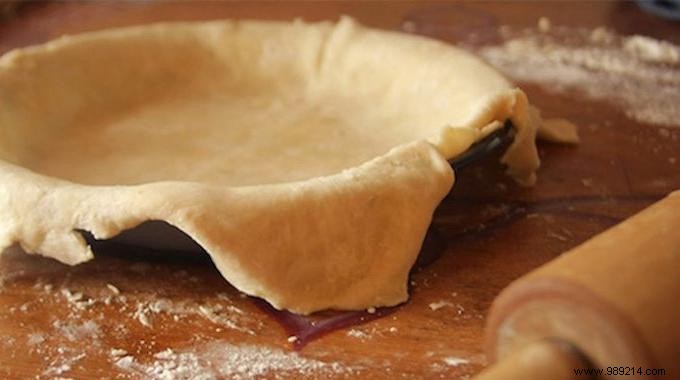
Are you a beginner and want to make homemade pie crust?
Or maybe you are already a real cordon bleu?
The secret to an unforgettable pie is to prepare a homemade dough.
And even for a pro, succeeding in a tender, golden-brown pastry with an airy texture and a good buttery taste is not easy.
Either way, check out these 10 simple and surprising tips for making your shortcrust pastry a success quickly.
Follow these 10 tips and you'll be fine. Watch:

Before you even start preparing, put your ingredients in the fridge. Flour, butter, sugar:everything!
Why ? When you knead the dough, it must be full of small lumps of fat. Once in the oven, they will create mini pockets of steam.
The result is an airy dough just the way we like it!
In the kitchen, you can always add an ingredient, but you can never take it away!
The amount of water is very important for the success of your dough. If you're following a recipe, use the minimum amount listed.
Instead of pouring everything all at once, add your water drop by drop. Water is what will initiate the formation of gluten. If you put too much, the result will be a dough that is too hard. Yuck!
Even better, try adding a little lemon juice or white vinegar to your water. The acidity will slow the development of gluten. Which means an even softer dough. Yum!
This is an error that I see frequently. Be careful not to knead your dough as if your life depended on it :-)
Why ? The warmth of your hands will boost the development of gluten. Consequence:the dough will firm up. Spreading the dough too much has the same effect.
So don't knead your pie more than necessary and spread it as little as possible.
Before rolling out your dough, put it in the fridge for 30 minutes. If you're not in a hurry, wait a little longer. This “resting time” will allow the gluten to relax. As a result, your dough will shrink very little in the oven! Another advantage, it will be easier to spread.
Place your dough between 2 sheets of baking paper. Brittle dough will not stick and tear less easily. Last advantage, it will make even less cleaning in the kitchen!
If you're like me, you're also a fan of covered pies. So, do not forget to make small slits in the dough that covers the pie. This will release steam and save you from soggy dough.
For a golden look, it's not rocket science. Beat an egg with a little cream. Apply the mixture to your pie with a brush for a beautiful golden color.
If you don't preheat your oven enough, your dough will simmer in the juices from the filling. As a result, it will soften.
Solution:preheat your oven to 220° (thermostat 7). Bake your pie and wait 30 minutes before reducing the temperature. Result, you will get a crispy batter just right.
A common problem is that the dough and the filling do not have the same cooking time. To prevent the edges of your pie from overcooking, make a shield.
Wait for your dough to be cooked. Then make a ring out of aluminum foil and cover the edges for a nice golden pastry.
Have you tried these grandma's tricks for making shortcrust pastry? Let us know in the comments if it worked for you. We can't wait to read you!